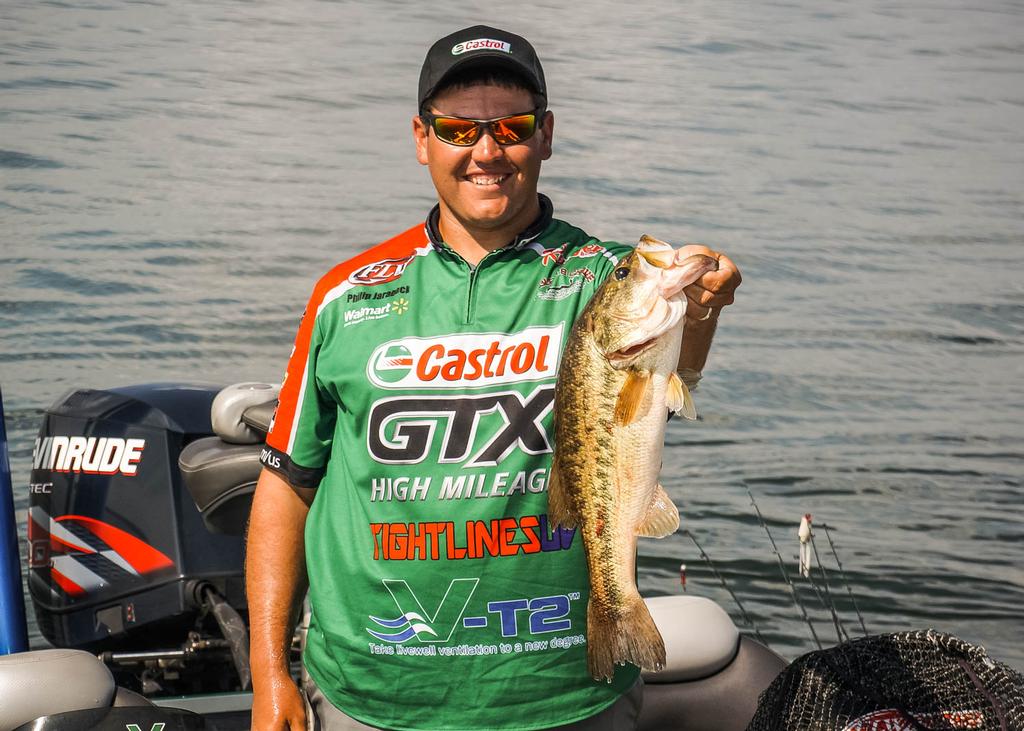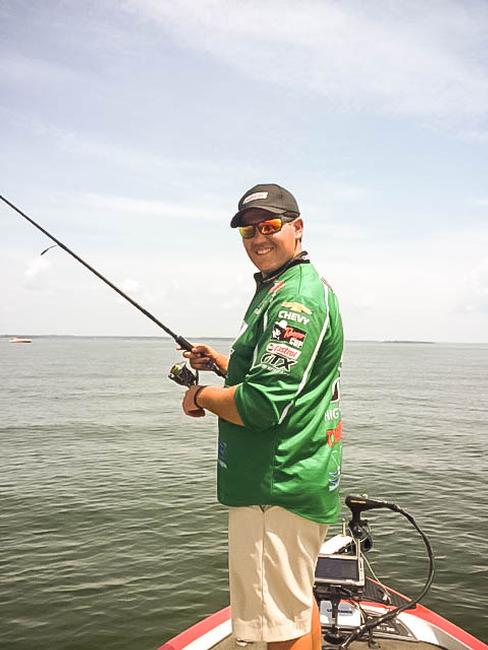Philip Jarabeck is Feeling the Heat

COLUMBIA, S.C. – “Only mad dogs and Englishmen go out in the noonday sun,” wrote British poet Rudyard Kipling. Obviously, he didn’t know any bass fishermen.
Philip Jarabeck is sweltering as waves of invisible UV rays from the overhead sun scorch any exposed layers of his skin. If that weren’t bad enough, he’s also feeling the heat of a.) leading the 2014 Forrest Wood Cup here on Lake Murray on day three, and b.) not catching any bass on a regular basis in this, the semi-final round of 20 aspiring pros. Time is ticking away, and the day is getting hotter. Around his Castrol flagship, eight boatloads of faithful fans wait patiently for him to rear back on his rod and bring a quality fish to the boat. The one bass presently residing in his livewell isn’t going to keep him in the game, much less in the Cup’s spotlight, as only the top 10 anglers from today’s competition will move on to the championship round.
“I expected it to be tough, especially by midday yesterday [Friday], but based on what I found in practice I thought it would be a super, super tough tournament the way it is now,” says the 24-year-old Virginia pro as he yo-yos a drop-shot rig over a deep brush pile. “I had about 14 or 15 pounds by this time yesterday. I had a 3-pounder right off the bat, and then a 5-pounder.”
Any Southern bass lake can be stingy during the dog days of summer, but Lake Murray is especially cruel to anglers. Cody Meyer’s tale of his pre-practice conversation with a South Carolina local serves as an example. He met the Palmetto State angler at a local gas station as he was refueling his boat.
“You fishing in that FLW tournament?” Meyer was asked.
After he answered in the affirmative, his inquisitor noted that Lake Murray was a great place to fish, “but not in August. We don’t even hardly take our boats off the trailers ’til October,” Meyer was told.
Still, the guiding principle is not how many bass the field can catch, but how many the winner can catch under the circumstances presented to him. Nobody predicted a smackfest here, and the lake is living up to expectations.
The problem, it seems, are the vagrant schools of protein-packed blueback herring that roam the 50,000-acre lake and upon which bass feed during the heart of summer. When forage fish pass rapidly over a bass hangout, they tend to take the bass with them as they go. Here and there, random bass drop off to loiter at offshore humps and bars, but they, too, are living in a world of here today, gone tomorrow. Jarabeck has been victimized by their wandering ways. He caught 10 keepers in the second round and actually upgraded his stringer weight three times during the day. He finished the day with 17 pounds, the day’s best stringer.
Assuming that Jarabeck and the 44 other anglers in the competition didn’t catch every bass in Lake Murray on Friday, the remaining fish are somewhere, but just not where they were yesterday. Blame those restless herring.
Two boats from Jarabeck’s posse idle away and then hit full plane for parts unknown. It is very hot, and there must be some cold sweet tea waiting for them somewhere. Oddly enough, they might be the true believers as compared with most of the boats that remain. Among them are scavengers, local anglers who set up on a pro, then wait for him to leave before passing over the spot he was fishing and waypointing the exact location with their GPS fish-finders for future reference.
“Come GPS these docks, sucker,” Jarabeck exclaims after a short run to the bank. He’s back doing what he did early in the second round that gave him a huge boost in the standings: skipping soft plastics under shoreline docks where, hopefully, bass will be lurking in the shadows waiting for an easy meal to pass by.
As opposed to the offshore nomads, Lake Murray’s dock bass can be more reliable. The problem is that all the docks have bull’s-eyes on them, figuratively speaking, for every passing angler to see. Somebody else has already caught the quality fish under them during the cool hours of the morning. Still, Jarabeck is banking on a few strays that others might have missed.
“My game plan was fishing docks early and then going offshore later in the day and fishing my spots,” Jarabeck says. “In practice, I only got a couple of bites on docks. I’ve incorporated it in, though, because I did get some quality bites, including the 5-pounder [on Friday]. The 3-pounder I caught before that was next to a dock. But it’s not been my main thing. Before today I was doing really well out deep.”
What’s his take on the big change offshore between Friday and Saturday?
“I don’t have a clue,” he says. “The fish might move off one brush pile, or maybe two, but not all of my spots. Something has changed. The only thing I ask myself is if it’s possible that there are so few fish out there? When you catch them, do you catch all that’re there? It might be part of it, but somebody is going to catch them out deep on a brush pile today.
“My hope is that with the cloudy, foggy skies we had this morning, the fish roamed a little farther away from the brush, and it’s going to take a while for them to get back. The overhead sun will help gather them up again.”
Perhaps, but it is very hot waiting. The last of the boats following Jarabeck in the morning have all gone. Even the scavengers have forsaken him now.